Louis Moinet Astronef: It’s Space, Jim, But Not As We Know It
The history of spacecraft spans at least three centuries. It both includes vehicles that have been launched into space by various space agencies and those designed for science fiction before and after humans actually became a spacefaring species. From both public and private space agencies we have seen incredibly unique, technically advanced crafts that have greatly expanded human knowledge over the last 70 years.
Outside of the crafts that humankind has built, there are tens of thousands that have been dreamed up by brilliant imaginations across the world. Science fiction and science fact go hand in hand, each inspiring one another in an ouroboros of creativity and engineering. Your favorite science fiction story likely has multiple original spacecrafts invented just for that story and may have drawn inspiration from things that have actually been built.
That works the other way around, too: fictional ships like the Heart of Gold from the legendary Hitchhiker’s Guide To The Galaxy, which was imagined to be mind-bogglingly beautiful (and shaped like a sleek running shoe) and could travel to every spot within the universe simultaneously thanks to its Infinite Improbability Drive. The fictitious Heart of Gold inspired real-life private space company SpaceX when it launched Elon Musk’s personal Tesla Roadster into space and used the iconic catchphrase “Don’t Panic” on the car’s touchscreen, proving that the wildest science fiction can still inspire the real world. (Musk is also planning to call his first Mars colony spaceship Heart of Gold.)
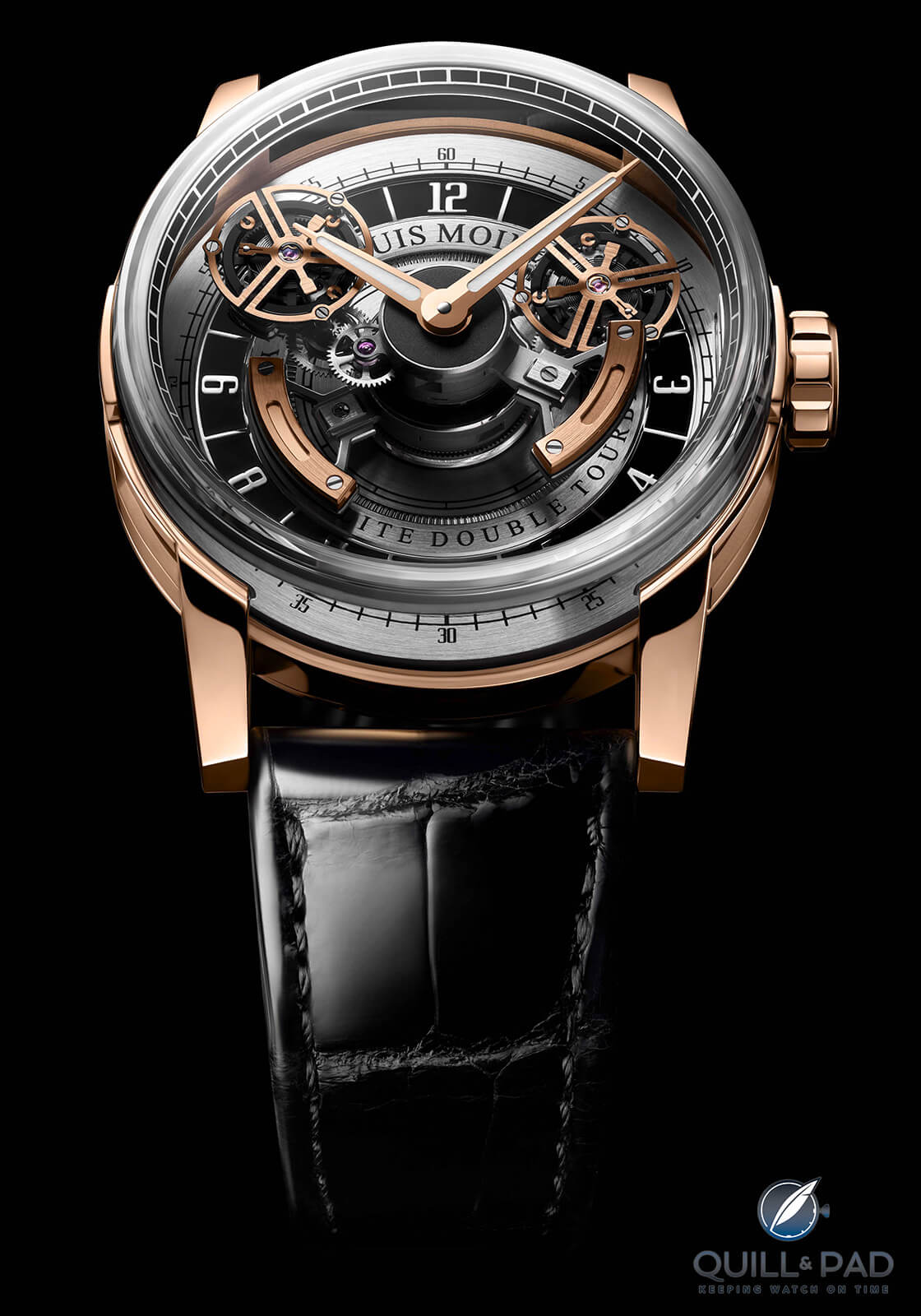
Louis Moinet Astronef
Sometimes inspiration can come from specific details as well as broader concepts. An excellent example is the new Louis Moinet Astronef, whose name means “spacecraft” in French, a follow-up to the brand’s incredible Space Revolution. With twin orbiting tourbillons and highly mechanical display, the Astronef builds on the stylistic spacecraft origins and creates something founded on the entire universe of spacecraft ideas.
Louis Moinet Astronef
The Astronef from Louis Moinet is an incredibly complicated “simple” watch displaying just the hours and minutes, but it does so with an out-of-this-world flourish. It is built around the concept of a pair of orbiting satellite tourbillons that revolve around the dial in two periods, one in ten minutes and the other in five. As the tourbillons rotate in opposite directions, this causes the two tourbillons to meet 18 times in an hour in different places around the dial.
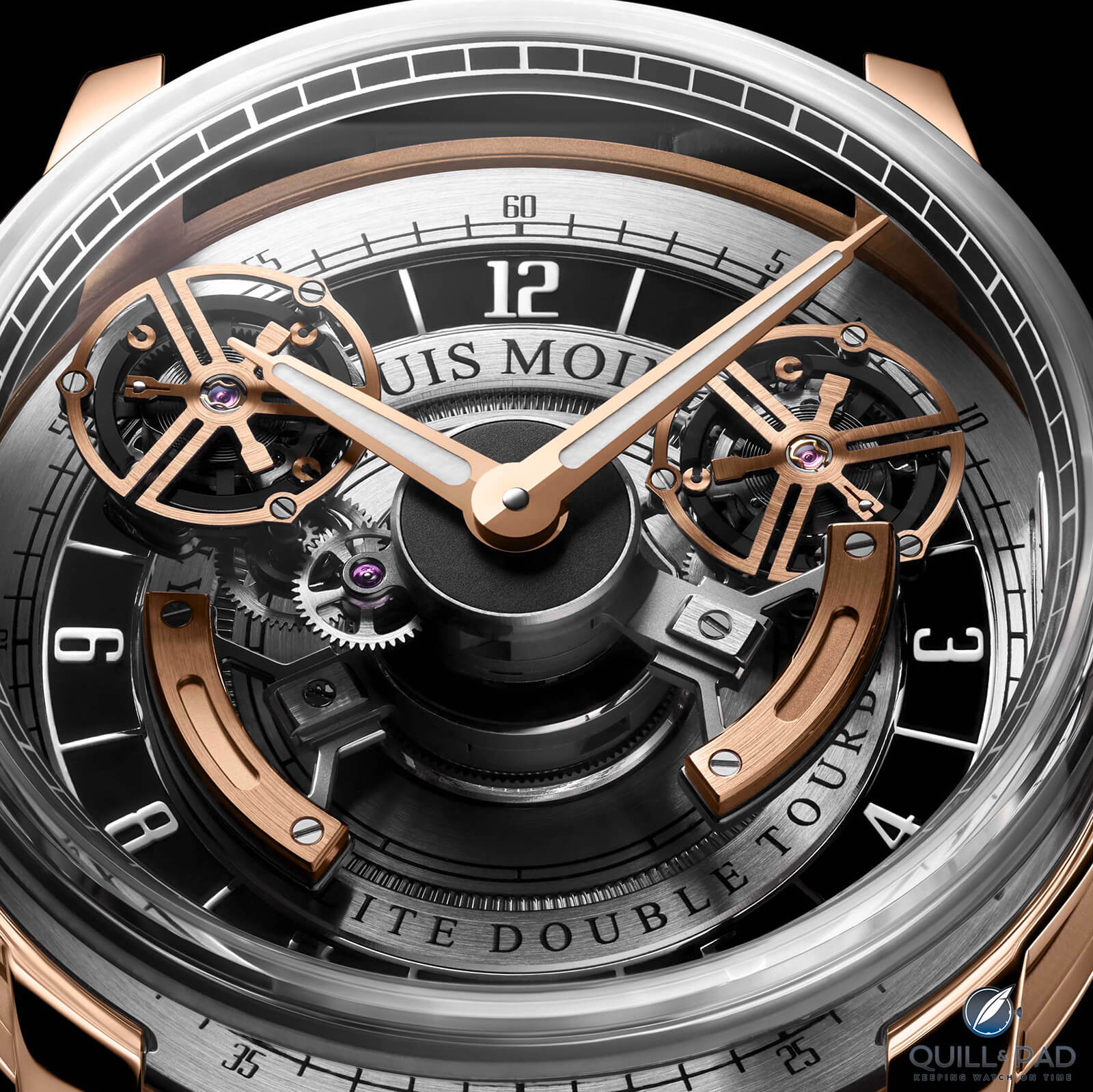
Dial of the Louis Moinet Astronef
The original Space Revolution model saw the tourbillons counterbalanced by miniature spacecraft models that appeared very familiar to fans of science fiction; the new Astronef does away with this thematic in favor of clean, geometric counterweights.
The tourbillon cages are simplified in contrast to its predecessor, which offered complex space station-like geometry. This has now given way to a clean, slotted, circular design that makes a full rotation once every 60 seconds. These tourbillons “fly” above the dial bearing printed tracks and numerals inside and outside of a ring of cutouts for the hour numerals.
In the center is the mechanical tower presiding over the dial and driving the twin orbiting tourbillons. Configured in a stepped format, the tower is essentially two mechanisms stacked on top of one another to drive the tourbillon assemblies and return their average timing rate back to the central hour and minute hands. Most of this watch’s thickness comes directly from this column of steel and gears.
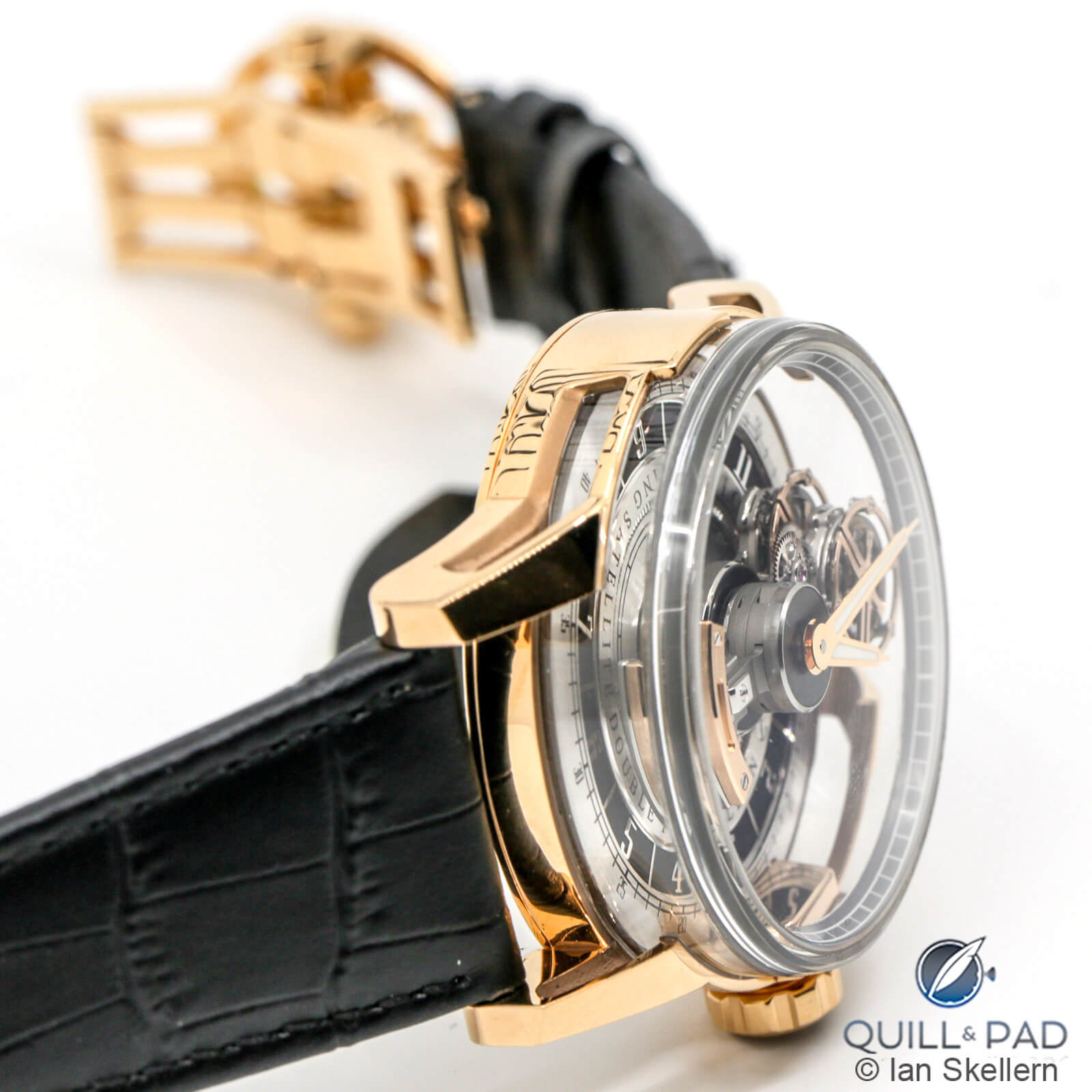
Louis Moinet Astronef
The case is designed as a frame surrounding a giant sapphire crystal covering the display like a dome. With cutout lugs and what is essentially a base for the crystal, a majority of the movement is on full display to maximize appreciation of the three-dimensionality and mechanical magnificence.
On the reverse side of the case we see the more traditional portion of the movement with the twin mainsprings, going train gearing, and a large golden function selector switch.
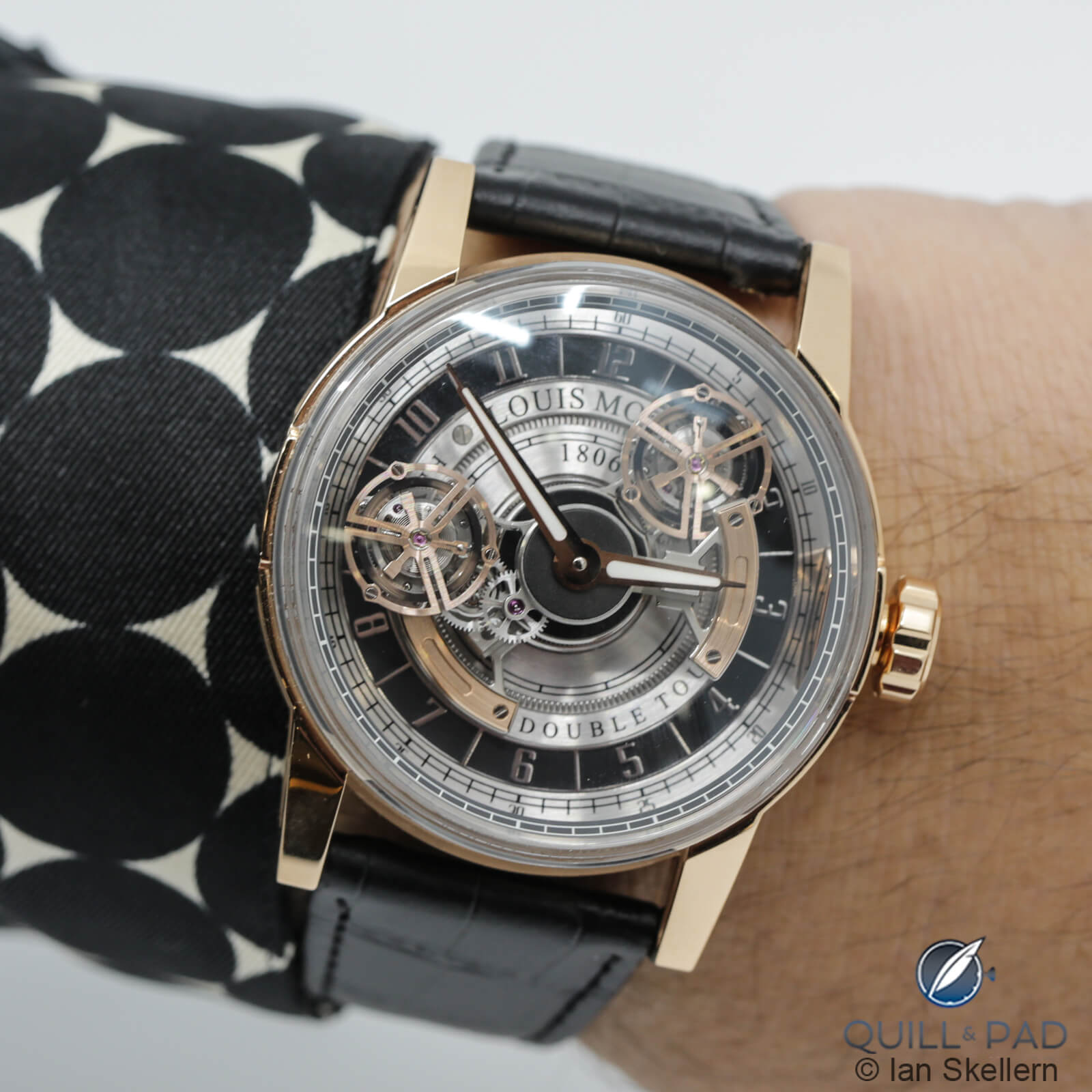
Louis Moinet Astronef on the wrist
Doing things differently
The switch replaces the functionality of a pull-out crown and allows the wearer to change between winding and time setting. The regular crown is used to either change the time or to wind the 48-hour movement without having to pull it out. One might wonder why Louis Moinet would have made this change since it still requires the use of a traditional crown, but closer inspection of the movement makes it clear: space. Not outer space but the physical space taken up by the twin orbiting tourbillons.
The stack of mechanics is so tall that this means the approximate middle of the case vertically falls right in the middle of the tourbillons, which is where the winding stem and keyless works would normally be; so that it was a no-go.
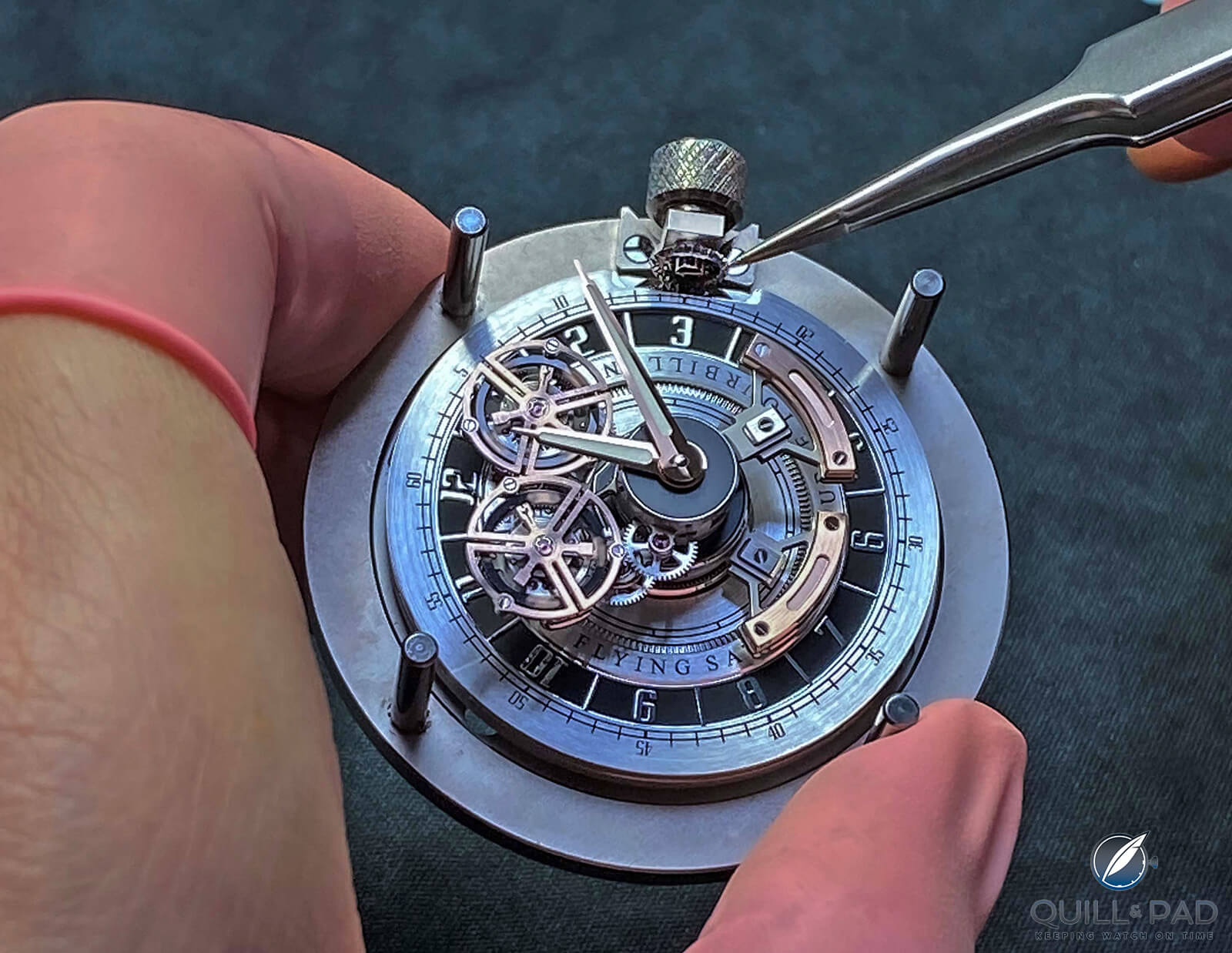
Louis Moinet Astronef movement, winding gear at top
To ensure the winding and time setting wouldn’t interfere with the operation of the orbiting tourbillons it had to be underneath the main plate. But this is effectively the rear of the watch and would have put the crown in a strange position, so a solution had to be found. The answer was to eliminate a pull-out crown mechanism and simply put a crown with a massive bevel gear into the side of the case.
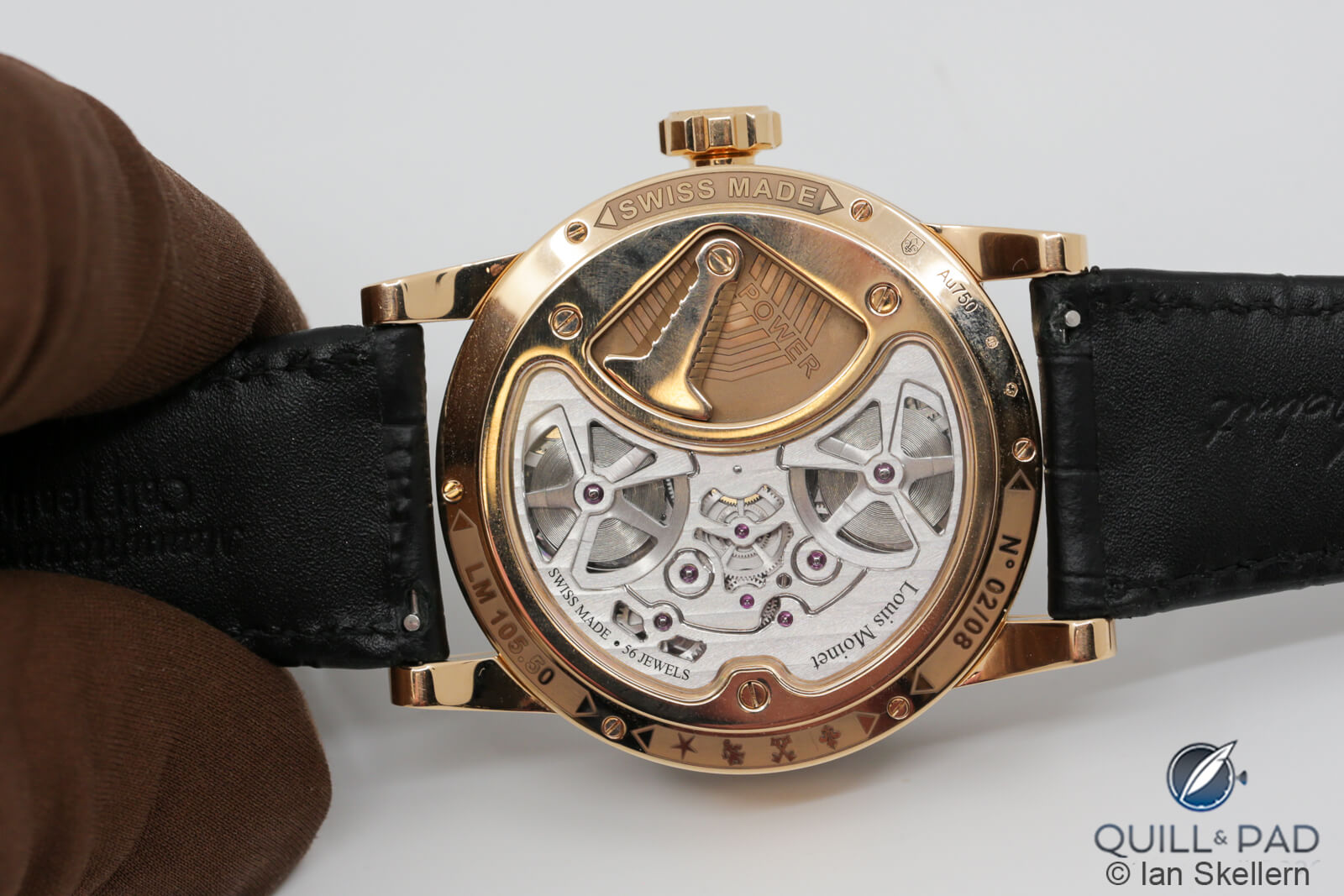
Back of the Louis Moinet Astronef
This component meshes with the keyless works underneath the dial and maintains the normal center-of-the-case position for the crown. The user simply flips the lever on the back of the case to select winding or time setting and uses the crown as normal. When seen in the context of the movement it makes perfect sense to incorporate this feature, but when developing the movement from scratch over the space of three years, I’m confident it caused a few headaches and some scrapped ideas.
But that is to be expected in developing a movement like this. Half the movement is squeezed into the 3.75 mm-thick base while the rest towers above the dial. These cylinders housing the gear trains leading to the tourbillons are mounted on ceramic ball bearings to reduce friction and provide a strong and stable rotation surface, clearly necessary for the large orbiting structures.
But, seriously, it’s different
In my opinion, the tourbillons themselves are less of a highlight than the tower and orbiting counterbalanced arms holding them. That was the basis for this movement: a grand display of mechanics perfectly in line with the Louis Moinet way of doing things. The biggest retreat from previous models is the dial underneath the twin orbiting tourbillons, which is a serious aesthetic departure from what one is used to seeing from Louis Moinet.
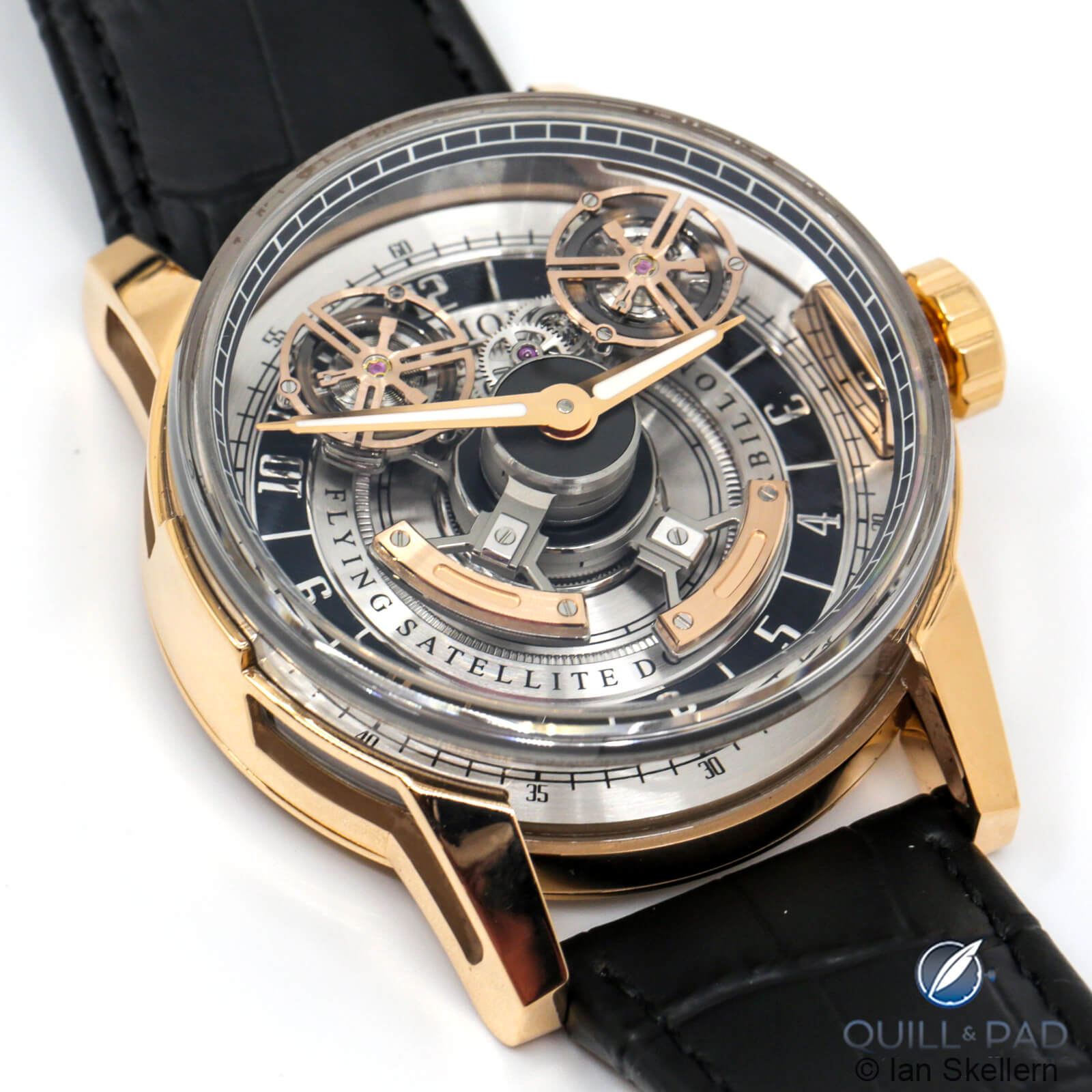
Louis Moinet Astronef
Looking back at the models that are available or have been released over the years, this type of dial layout, typography, and finishing is new, marking a fairly stark shift from the “usual” métiers d’art-style dials, stone dials, or boldly abstract dials. The geometrically inspired numerals, the negative cutouts, and the simpler black-and-silver finishing make this watch feel like it could be from a different brand.
But it’s clear that the “DNA” of Louis Moinet is present in the mechanics and the boldness of the case. The forerunner to the Astronef, the Space Revolution, even has a much more typical-for-this-brand aventurine dial, so the Astronef is aesthetically a clear shift, and I’m happy to say that I really like this direction.

Louis Moinet Astronef movement
If Louis Moinet decided to use this type of design combined with the wild mechanics it is known for, I think it could effectively create an entirely new line. Currently, Louis Moinet separates its watches into Cosmic Art and Mechanical Wonders, and I think focusing on this style could add a new designation, perhaps the Industrial Perfection collection (cheesy, I know). Regardless, I was very excited to see this differentiation when it was released since I adored the Space Revolution but for entirely different reasons, and this piece stands incredibly strong on its own.
It truly is different than what Louis Moinet has made before, yet it feels perfectly at home in the lineup. It’s a testament to what changing some shapes, finishes, and decorations can do to a watch even as wild as this. It is still using the same massive sapphire crystal dome, the same openworked case, and largely the same movement but the feeling is so much different.
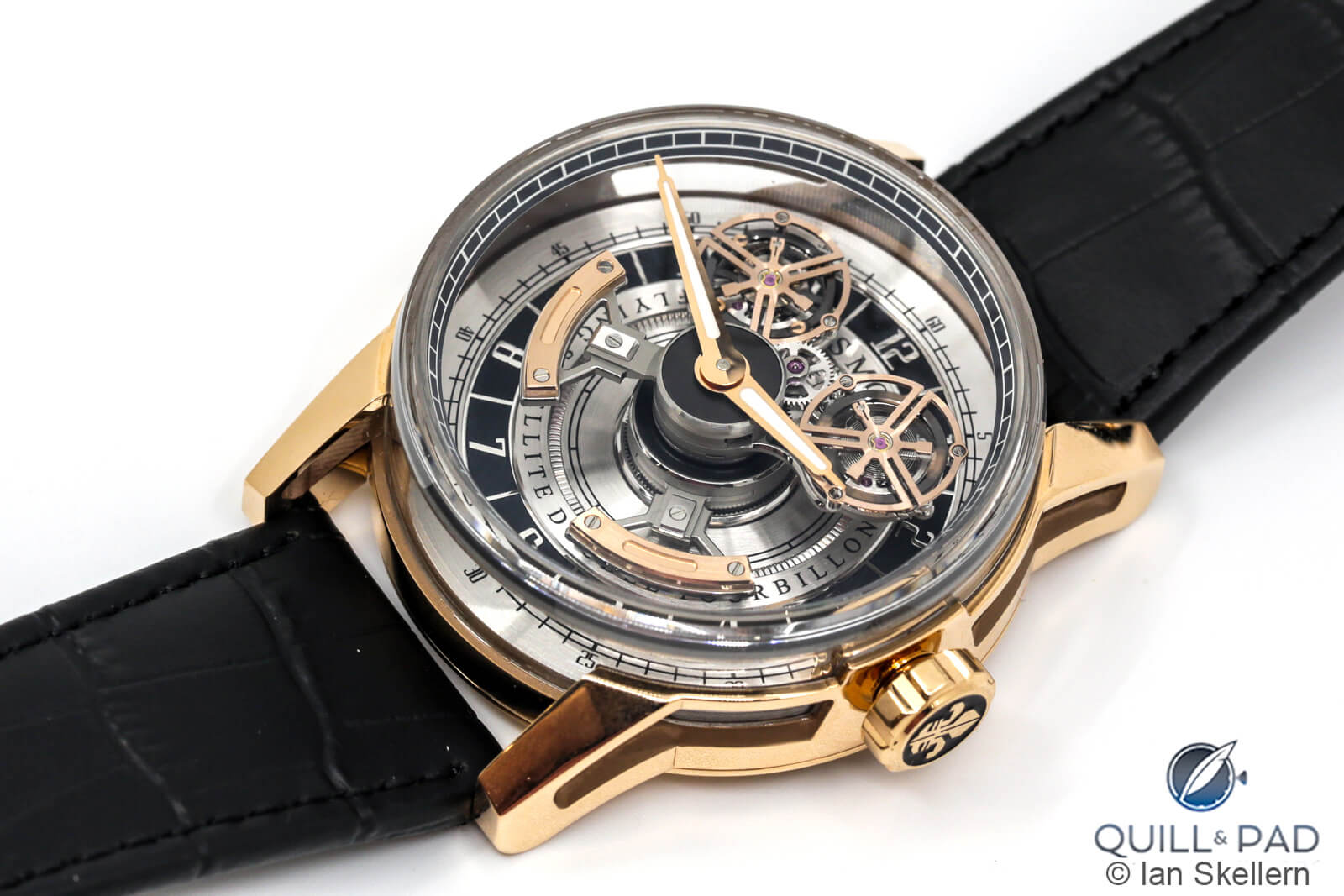
Louis Moinet Astronef
Despite being a limited edition of only eight pieces, I do hope the Astronef inspires future aesthetic directions, even with simpler watches, because I feel it could be a winning combination with the boldness of Louis Moinet. It certainly has my admiration and in a completely new way than the brand did before!
I promise I’ll be careful, but let’s break this one down!
- Wowza Factor * 9.4 This is a watch that demands a wow otherwise we might need to check your pulse to see if you are still alive!
- Late Night Lust Appeal * 94» 921.825m/s2 With two orbiting tourbillons you can only imagine the amount of G forces that would need to be applied to keep my jaw from hitting the floor!
- M.G.R. * 70 This is an incredibly geeky movement, no doubt about that. With the creation of a towering mechanical display of two orbiting 60-second tourbillons, Caliber LM105 stands proudly as one of my favorite movements in recent memory.
- Added-Functionitis * N/A At this point who even needs extra functions, just go without the Gotta-HAVE-That cream and revel in the mechanics!
- Ouch Outline * 12.2 Always cut away! Any experienced maker will tell you that if you have a sharp blade (and especially if you have a dull blade) you should always cut away from yourself. No matter how careful you are there is a moment when you slip and slice something on your body, and that is a self-imposed injury that I would love to avoid. But if it meant I got this on my wrist I just might “forget” that advice!
- Mermaid Moment * What a display! A five-and ten-minute orbiting pair of tourbillons: your heart knows before your brain that you are hopelessly head over heels!
- Awesome Total * 870 Start with the diameter of the case (43.5) and multiply by the water resistance in meters (10), then multiply by the number of orbiting tourbillons (2) to land on an out of this world awesome total!
For more information, please visit www.louismoinet.com/watches/astronef.
Quick Facts Louis Moinet Astronef
Case: 43.5 x 18.3 mm, pink gold and sapphire crystal
Movement: manually wound Caliber LM105 with two orbiting 60-second tourbillons, 48-hour power reserve, 21,600 vph/3Hz frequency, twin mainspring barrels
Functions: hours, minutes; crown function selector on back (winding and time setting)
Limitation: 8 pieces
Price: CHF 360,000
You may also enjoy:
Louis Moinet Space Revolution 2021: Science Fiction Fantasy Space Battle On The Wrist
Louis Moinet Spacewalker: Spectacularly Highlighting First Human Spacewalk By Alexey Leonov



Leave a Reply
Want to join the discussion?Feel free to contribute!